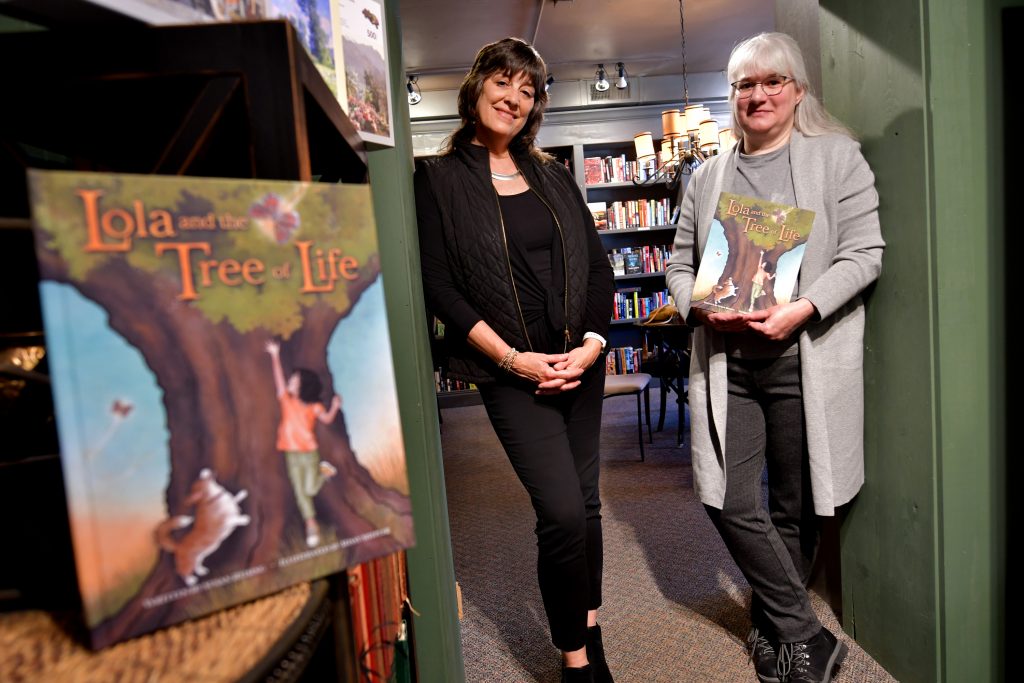Illustrated book helps children—and adults, too—cope with grief.
Everyone experiences grief. It can bring overwhelming physical and emotional suffering. While mental health professionals say this is a natural response to loss, many adults struggle to cope with these feelings. How, then, can they explain grief to a child?

Author Susan Reising, 60, of East Peoria and illustrator Missy Shepler, 61, of Chillicothe are making that conversation easier with their book Lola and the Tree of Life. The picture book follows Lola, a little girl whose grandfather is ill. With the friendship of her dog, Skye, and the wise words of an old oak named Tree, Lola comes to understand the cycle of life and death.
“I remember early on, we talked about who’s going to choose this book and how they’re going to use it,” said Shepler. “For a kid’s book you always look at, is this kid-appropriate? Is a child going to understand what this means?”
Reising’s hopeful prose and Shepler’s vibrant illustrations have resonated with many parents and counselors for introducing a difficult topic in an approachable way. Reising wanted families of different backgrounds to be able to share the story without it conflicting with their personal beliefs.
Twenty years ago, when she first began the book, Reising was sorting through a difficult transition. Her job was becoming increasingly stressful. She was earning a master’s degree in liberal studies that was expanding her worldview. She sought peace in nature as thoughts about empathy, loss and starting her own business weighed on her mind. Unexpectedly, it was a quantum physics lecture on entanglement theory that brought everything into focus.
‘We act like I end here and you start there, but really everything is connected.’ — Susan Reising
In its simplest form, entanglement theory says that any two particles that interact with each other will always be connected, even if they get separated by great distance. In fiction, the theory is often applied to love. Reising saw the theory in a more spiritual sense.
“I had been on a bit of a spiritual quest and just trying to make sense of the world,” the author recalled recently from the Peoria Heights bookshop, I Know You Like A Book. “There’s scientific proof that at the sub-atomic level, everything is made of the same thing. We act like I end here and you start there, but really everything is connected. For some reason that gave me a lot of hope, gave me solace.”
Reising felt drawn to share the idea with others. A children’s book seemed a natural medium. It could convey the idea in a simple form to people of many ages. The first draft flowed out of her like it was meant to be, she said.
At the time the book was about a boy losing his grandfather. Reising asked her coworker, Missy Shepler, to create some illustrations. Shepler agreed, mocking up panels that could be shared with publishers. The book needed buy-in from a company that would promote and distribute it, but none of the publishers felt like the right fit to Reising.
“I always felt bad,” Reising recalled. “She did these beautiful illustrations and made it easy for me to submit to a publisher and I just got cold feet and I didn’t do it.”
Shepler took the admission in stride: “Wait for the right time.”
That’s what Reising did. She put the book away, not knowing that years later it would be needed.
In 2019 Reising’s dog, Lola, died unexpectedly. Shortly thereafter, COVID caused statewide shutdowns. Reising saw people losing loved ones without getting to say goodbye,
“We were deep in political divisions that had been really hard on a lot of people. And then we get COVID on top of it. Add my personal grief and I was just like, how much more can a human take?”
To process her own grief, Reising reworked the book, adding in a dog and changing the main character to a girl named Lola in honor of her beloved pet. When she realized the manuscript could be self-published, Shepler was the only person she considered as an illustrator.
Both author and illustrator agree that the publishing delay made the book more relevant. People are seeking ways to process their grief and there is a growing resurgence of environmental awareness. The rise of the self-publishing industry has allowed the book to reach readers as far away as Australia, something that would have been impossible 20 years ago.
Shepler likes how breakthroughs in digital painting allowed her to play with different techniques to highlight the book’s themes. She finds a deep connection with the natural world and enjoys how the book presents nature as a safe space. Readers clearly see this in her illustrations, which Certified Grief Counselor Liz Pollack said are “full of movement and light and help keep the heavy subject matter at an age-appropriate level.”
The book’s impact has greatly surpassed the suggested age-appropriate range of four to eight. Reising has received notes from adults who have found comfort in Lola and the Tree of Life. One woman is using the book to tell her grandchildren about her incurable disease. A widower says the book brought back the hope he found sitting under an oak tree after his wife passed away.
“My goal was to help people,” Reising said, “but I don’t know if I thought through tangibly what that was gonna be like. It’s already been really gratifying.”
The book’s website has resources to continue the discussion about grief. There, readers can find coloring pages and talking points for children or TED talks and helpful articles for adults.
You can learn more about Lola and the Tree of Life, and find the supplemental resources at www.lolaandthetreeoflife.com.





